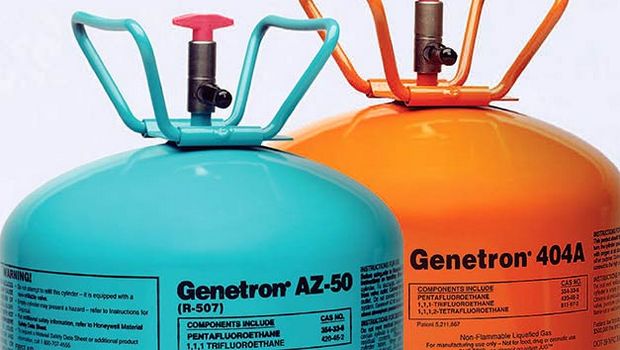Honeywell to stop sales of R404A

Honeywell says it intends to stop selling the high GWP refrigerants R404A and R507 in Europe from next year.
In a statement today Honeywell says it plans to exit the sale of Genetron 404A (R404A) and Genetron AZ-50 (R507) refrigerants in the European Union in 2018 as contracts permit..
One of the worlds main refrigerant producers, Honeywell explained that it was taking this action “in anticipation of the expected scarcity of high GWP products due to the F-gas regulation phase-down schedule”.
Prices of R404A and R507 from all manufacturers and suppliers have risen dramatically this year in anticipation of the 37% cut in CO2e required next year under the European F-gas regulations. Chemours recently announced consecutive monthly price rises of 25% and 30% on these high GWP gases, and warned of shortages next year, but Honeywell is the first manufacturer to announce it is to cease to supply.
This latest announcement is certain to add further inflationary pressures to R404A refrigerant prices and may prompt the other manufacturers to take similar action.
Europe is now just months away from the F-gas phase-down “cliff” in 2018 which will see a 37% cut of the baseline. In practical terms this means the European industry will have to make do on a maximum of 115Mt CO2eq – a little over two-thirds of the 168Mt CO2eq consumed in 2015.
“Due to the large, mandated reduction in quota to be implemented on January 1, 2018, it is expected that an accelerated phase-out of high-GWP products will be required in order to cope with the phase-down timing,” Honeywell says. “This means that customers need to convert now to more environmentally preferable solutions in order to prepare for the scarcity of high-GWP products anticipated in 2018 and to fully meet the F-gas requirements by the end of 2019.”
Julien Soulet, managing director for Honeywell Fluorine Products in Europe, Middle East, Africa and India, warned: “Given the upcoming targets set by the F-gas regulation, customers will soon encounter reduced availability of high GWP products. We encourage refrigeration customers to work closely with Honeywell’s authorised distributors to accelerate the transition to near drop-in replacement products that are available now and fully comply with F-gas regulations.”
With quotas based on CO2 equivalents, no manufacturer wants to continue selling high GWP gases like R404A. They have spent millions developing retrofit gases which, due to their lower GWPs, they would be able to sell 3x as much of compared to R404A.
Honeywell points to its own lower GWP alternatives such as R407F and R448A. Others manufacturers like Chemours and, more recently, Daikin, also have lower GWP alternatives. Although currently more expensive than R404A and R507, the price differential of the replacements is rapidly reducing and all of the alternatives are said to offer improved energy performance.
Honeywell says its will work with its network of authorised distributors to help customers and partners to adopt the next generation refrigerants that best meet their needs but warns that significantly reduced amounts of R404A and R507 will be made available to bridge shortfalls in the transitional period.
The phase out of the use of high GWP refrigerants is seen as essential if refrigerant shortages are to be avoided next year. Groups such as EPEE have previously warned that this would require the retrofitting of at least 50% of current R404A systems. Reports suggest that Europe is currently far short of that target and, worse, new equipment using R404A is still being manufactured, imported and installed in large numbers.
R404A, with its GWP of 3922, is the most widely used gas in Europe in stationary refrigeration systems, commonly used in low temperature commercial systems such as those used in supermarkets. R507 has a GWP of 3985 and, although less common, is also used in low and medium temperature refrigeration.
Both R404A and R507 were introduced in the 1990s to replace ozone-depleting CFCs R502 and R12 and, later, the HCFC R22. At that time, global warming and the effect of high GWP refrigerants were not considered.
